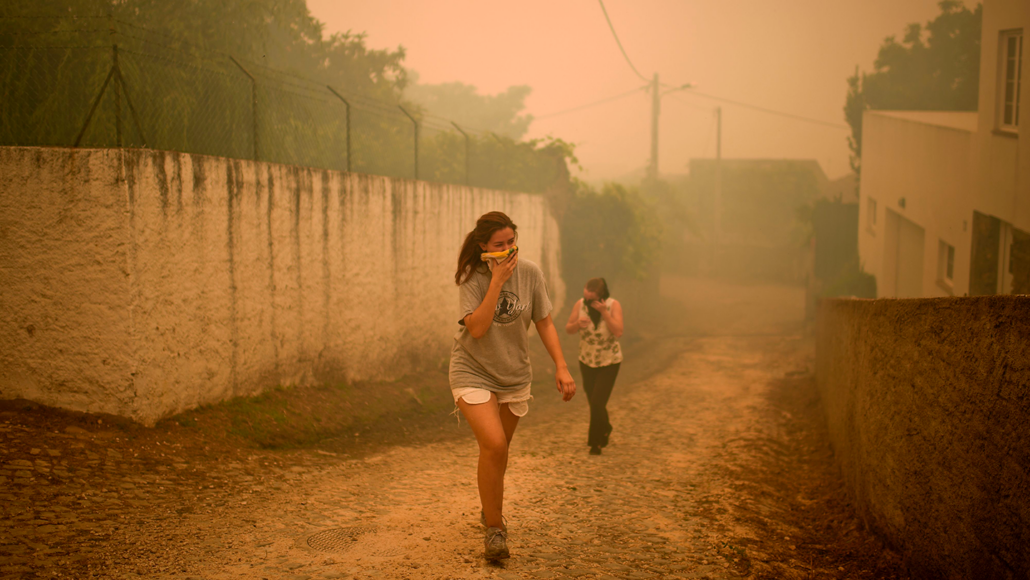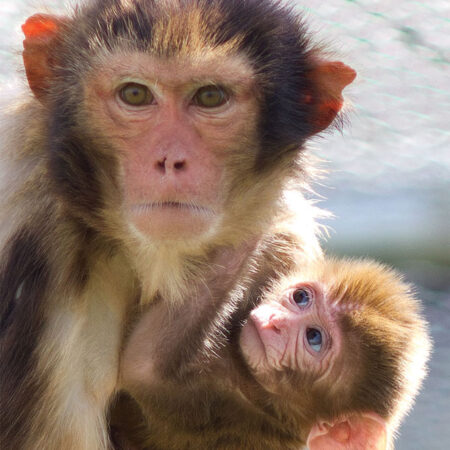Wildfire smoke seems to pose its biggest health risk to kids
New studies point to vulnerabilities affecting kids' airways, brains and immune systems

People in Portugal cover their mouths to try to filter out smoke from a nearby wildfire on June 18, 2017. Emerging data show that breathing wildfire smoke is particularly hazardous — especially to children.
PATRICIA DE MELO MOREIRA / Stringer/AFP/Getty Images Plus
By Megan Sever
“Asthma is a very widespread common health condition,” notes Yang Liu. He’s an environmental scientist at Emory University in Atlanta, Ga. Up to 8 percent of U.S. children suffer from this breathing problem. It temporarily shrinks the airways, which makes it very hard to breathe. Emerging data now show wildfire smoke appears especially good at triggering asthma problems in kids.
But it’s far from the only threat this smoke can pose to children and teens.
Researchers have been studying the impacts of tiny airborne pollutants. Known as aerosols, they are made up of a mix of tiny dust-sized particles and droplets. Aerosols no more than 2.5 micrometers wide are especially worrisome. (They’re about one-thirtieth the width of a human hair.) At that size, they can be inhaled deeply into the lungs. Referred to as PM2.5, they have been linked with breathing-related injury. The tinier these pollutants are, the more deeply they can enter the airways to settle in and do harm. Studies have shown small ones can even go up the nose and into the brain. (To get there, they pass through a structure known as the olfactory bulb.)
Inhaling tiny aerosols can be a danger to anyone. Children, however, face an elevated risk. One reason: Children breathe faster. That means they end up inhaling more air — and any pollutants in it. Their lungs also are smaller than an adult’s. So more of the lungs’ surface will be exposed to whatever is in dirty air. Finally, kids’ lungs are still developing, notes Jennifer Stowell. She works at Boston University School of Public Health in Massachusetts. As an environmental epidemiologist, she’s sort of a disease detective.
Stowell led a study in the January Environmental Research Letters. It estimated how much wildfire smoke will worsen asthma among people in the western United States.
Asthma, for which there is no cure, inflames and narrows the tubes moving air in and out of the lungs. And it’s common. Based on current trends, Stowell’s team now estimates that within another 25 years or so, there will be some 155,000 more asthma-related hospital visits each year in the West — just from exposure to wildfire smoke. Children, teens and younger adults may face the biggest risks, Stowell worries.
Wildfire pollution appears uniquely harmful
Wildfire aerosols no bigger than PM2.5 were 10 times as harmful to lung health in preschoolers than other aerosols that size. That’s the conclusion of a team of researchers in the April 2021 Pediatrics. Rosana Aguilera led this team. She’s an environmental scientist at the Scripps Institution of Oceanography in La Jolla, Calif.
She was also part of a team that in 2020 showed that even a small rise in PM2.5 smoke aerosols increased hospital and urgent-care visits in kids and pre-teens. “Even relatively smaller wildfires can still generate quite an impact on [children],” Aguilera concludes. That’s because “any amount of PM or air pollution is harmful.”

Especially worrying are some recent studies in monkeys. They have shown permanent effects of exposures to wildfire smoke in the young. The researchers expect to see much the same things in people, given how genetically similar our species are.
Hong Ji is a biologist who works at the University of California, Davis and its primate center. She notes that one 2017 study found that by age 3, macaque monkeys exposed to smoke developed immune and lung problems. Ji wasn’t involved with that study, but she’s familiar with its findings. Some of her UC Davis colleagues took part in the work. Their animals’ lungs looked like they had fibrosis (Fy-BROH-sis), she says. That’s a thickening and scarring of the tissue. Exposure to the smoke early in the monkeys’ lives impaired how their lungs developed, she notes. And, she adds, that doesn’t appear to be reversible.
Ji’s own work shows that breathing wildfire PM2.5 also changes how DNA works in these monkeys. This past January, her team reported those findings in Environment International. Infant exposures to wildfire smoke caused life-altering changes in a monkey’s nervous and immune systems. It also altered their brain’s development. Even worse, Ji says, the DNA changes her team found are a type that can be passed down, inherited by their babies.
Ji and her colleagues have now teamed up with Rebecca Schmidt, an epidemiologist. She too works at UC Davis. This group is investigating how wildfire smoke affects pregnant women and young children. They also are looking into whether PM2.5 causes genetic changes in babies exposed to smoke in the womb, Ji says.
Already, one study earlier this year turned up learning, immune and hormone problems in macaques exposed to wildfire smoke in the womb. Ji says that the more researchers learn about the effects of wildfire PM2.5 on babies and children, the more dangerous we realize it is.







